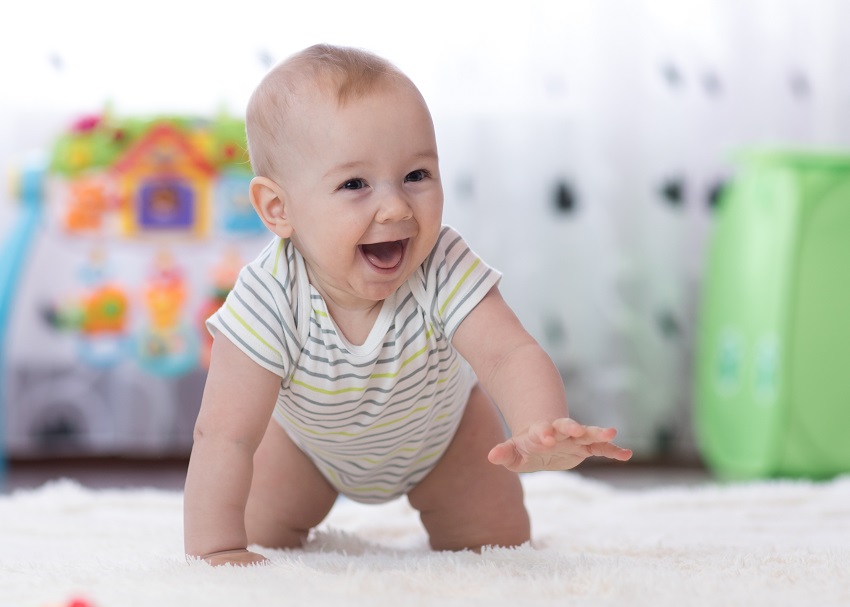You might be eagerly waiting for the moment your baby begins to crawl. While that’s perfectly normal, it is important to remember that there is nothing wrong if your baby has not started crawling as soon as your friend’s child did. In some cases, that delayed crawling might only mean that your child has delayed motor development. Moreover, it is even normal for some babies to skip crawling altogether; instead, adopting other ways to move around their homes.
When do babies generally start crawling?
Do you know when crawling stages of babies kick off? While there are certain studies that indicate that 50% of babies begin crawling by the age of 8 months, there are some that might start before 6 months and yet others not until after 11 months!
The truth of the matter is, babies are not inherently ‘programmed’ to crawl. They are, instead, motivated to experiment with different modes of movement, and find which one works best for them.
When do babies start walking?
Babies generally start walking around 10 and 18 months of age. They begin to walk after successfully learning how to crawl, usually between 7 and 12 months. Every skill your little one knows during the crawling stage helps them in the next stage of development. Further, their learning also gets complex. When your little baby was occupied crawling and putting all its strength to stand, it was building muscle strength. From crawling to the walking stage, the baby learns skills related to balance and coordination.
Discover 5 Types of Baby Crawling
Let’s get right down to floor level, then, and see how babies navigate the world around them!
- The Cross Crawl
- The Bear Crawl
- The Crab Crawl
- The Step-Crawl Mix
- The Commando Crawl
This one’s the usual crawling style, where the baby rests its weight on its hands and knees, moving an arm and the knee opposite it simultaneously, to move forward.
This crawl is similar to a baby crawling on their hands and knees, but with a major difference. Baby holds their abdomen high and keeps their knees off the ground, balancing on their hands and feet.
This one sees babies moving their body backwards or sideways in the crawling position, before launching their body forward with their hands.
This one’s a proverbial mash-up of the hands-and-knees crawl and bear crawl. Baby crawls on the knee of one leg, while stepping on the foot of the other.
Time for some stealth movement? This one has a baby literally moving like a commando, their tummy touching the ground while they alternately move an opposite arm or leg.
Rolling. Well, not quite crawling, but it just about makes the cut! Why struggle to crawl, when you can roll instead?
Have you cracked the puzzle of your baby’s crawling type yet?
“Try and fail, but never fail to try!”
-Jared Leto
3 Beneficial Crawling Exercises for Babies
As a parent, you can encourage your baby to walk through continuous attempts of trial and error. It’s important to give your baby that much-needed nudge, when it comes to helping get them started in the wonderful new world of crawling that awaits them. Exercises like the following can help do just that.
- Simple Stretching
- Downward Facing Dog
- Twist and Turn
You stretch before exercising, right? Similarly, crawling is exercise for babies!
How: Have the baby lie on their back and put their legs in the air. Then, gently hold onto their feet, with their knees bent and legs open wide, to facilitate some wonderful stretching. Later, have them hold their feet and sway back and forth on their own. Simple stretching is one of the ways babies start crawling.
Ideal for: Opening hip muscles and stimulating digestion.
This is actually the simplest pose, but you want to wait until at least 8 months when the baby has started crawling on their own.
How: What baby has to do here, is put both their hands on the floor and their butt in the air. The downward facing dog is one of the helpful exercises for baby crawling.
Ideal for: Flexibility, motor skills.
When do you think babies start crawling? Crawling exercises for kids are great when they offer some lovely incentives, and they begin to walk.
How: Place some of the baby’s favourite toys on either side of them, so they have to twist and turn to reach them.
Ideal for: Helping baby transition from the sitting position to the hands-and-knees position.
Expert Tips to Help Your Baby Crawl
There are plenty of great ways to ensure that your child’s crawling experience goes off more smoothly. Here are some of the pro tips to ensure a smooth experience when babies start to crawl.
- When do babies start crawling?
- Child-proof your home
- What encourages babies to start crawling?
- Crawl with them
- Clearing the Path: 3 Pitfalls to Watch Out when Babies Start Crawling
- Baby Walkers
- Too much time spent in baby seats and carriers
- Pushing your child to learn crawling
When they are given loads of tummy time. When babies play on their bellies, they are developing the strength in their shoulders, arms and trunk – the very strength needed for them to crawl.
First of all, you want the space your baby is crawling through, to be safe. Do a thorough recce of your home (this might include you crawling, too) in order to see that the place is child-proof and crawl-ready!
Placing toys that are just out of reach of the baby will motivate them to move towards it. This one’s taking the exercise outlined above, to a whole new level. After your child can twist and turn with ease, it’s time for them to make a more ambitious effort to reach for that toy.
This is probably one of the most overlooked ways of teaching your baby to crawl. The thing is, children learn from what they see; so, getting down on all fours and crawling yourself, might not be such a bad idea after all. Crawling with them also gives them a nudge to start crawling and eventually walk.
Now that you’ve seen the things you can do to facilitate baby crawling, let’s look at the things it would be better to skip, when it comes to assisting in those precious baby crawling stages.
Not only are those baby walkers potentially dangerous, but they can hamper muscle development in infants, too. What’s more, they can eat away into that precious crawling time on the floor!
When you do this, what you are in effect doing is not allowing the baby enough time to play, move and explore the world around them. If you really want to help the baby crawl, you have to set them free!
The last thing you want to do, really, in those fragile baby crawling stages, is to push them too hard to learn to crawl. If you do this, the only thing you will end up doing, is reversing any positives they might have already gleaned out of the crawling process.
Conclusion
Watching your baby learn to crawl can be both exciting and scary. While most children learn at their own rhythm and pace, you can give them that much-needed boost to help them explore the world around them, when crawling around. Do you have anything new to share with us which you lovely parents or grandparents know?
For informative and accurate articles on all things related to your new born-toddler’s development, growth, health and nutrition, follow EuroKids Blogs and do check out our nationally recognized preschools – EuroKids for the first step in your kid’s educational journey!
















